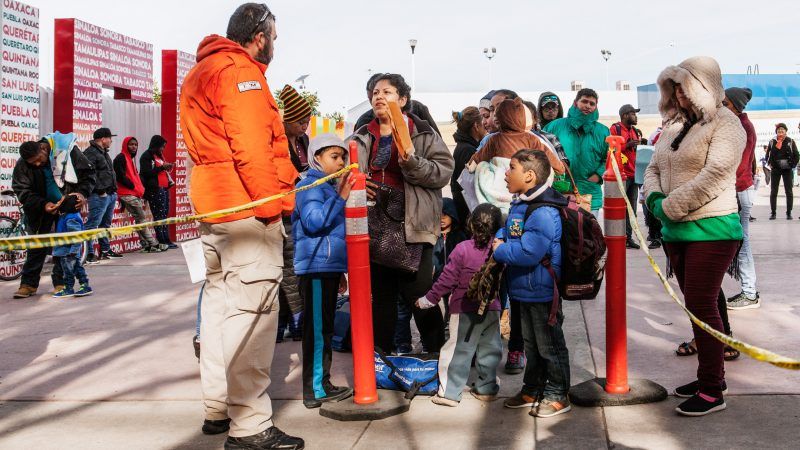President Trump's New Asylum Ban Will Lead to More Illegal Immigration
It will backfire bigly. The better border solution is more work visas for Central Americans

The Trump administration is trying to end asylum as we know it for Central American migrants and others coming from the southern border effective today. The Department of Homeland Security and the Department of Justice issued a rule that would make asylum seekers who come to America by land ineligible for asylum unless they have first applied—and been denied—in the countries they transitioned through.
I explained in The Week today that the rule is unlikely to withstand the legal challenges that the American Civil Liberties Union (ACLU) and other outfits have pledged to file within 48 hours. This is not only because the administration is trying to accomplish through administrative fiat what it couldn't through legislative means, basically doing an illegal end run around Congress, but also because the rule violates standing American law that requires all asylum seekers to get a hearing. It also bars America from consigning these migrants to countries where they aren't actually safe, which is what the administration is effectively trying to do.
The administration maintains that America's asylum laws have become a magnet for all kinds of people with all kinds of motives not just those who are fleeing persecution and danger. This has strained the country's border resources and stressed its processing capacity to a breaking point. As proof, the administration notes that the denial rate for asylum seekers has been steadily rising and touched 65 percent in 2018.
That rate, actually, is hardly unprecedented or hugely out of line with past trends.
More to the point, the spike corresponded with the time when former Attorney General Jeff Sessions narrowed the asylum criteria and made women and children fleeing domestic and gang violence ineligible. This affected families who arrived under old assumptions, notes Zuzana Cepla of the National Immigration Forum.
But will scrapping asylum actually prevent migrants from "forum shopping" for a country not based on safety considerations but economic ones, as the administration insists they are doing?
Not likely.
For starters, as Migration Policy Institute's Susan Fratzke has noted, if the United States starts turning away migrants arriving by foot through other countries, they will find more direct routes (via the sea, for example). And just because America bans migrants and refugees transitioning from Guatemala and Mexico (countries with whom America is laughably trying to sign a "Safe Third Country" agreement) doesn't mean they'll stay there. They'll just enter America without authorization, re-upping the illegal population that has been plummeting for years now. "This could contribute to creating deeper and more sophisticated smuggling networks in the region and extending into the United States," she notes. In other words, the asylum ban will backfire bigly.
So what is the real solution?
As I have noted before, Central American migrants certainly do have multiple motives for coming to the United States. They are looking for the quickest way out of gang violence and political instability. But such conditions also lead to economic destitution, so they are also looking for jobs. The main reason they end up using the asylum route is because guest worker visas are even harder to land. Moreover, unlike asylum, they don't offer an option for permanent residency in America.
But asylum taxes border resources more than any other admission route because of the copious processing involved. And the Trump administration's zero-tolerance policy has made matters infinitely worse because, unlike in the past, migrants are now detained on the U.S. taxpayers' dime rather than released to friends and families while their claims wend their way through hopelessly backlogged immigration courts.
The better way to relieve the strain on the asylum system would be to make more low-skilled work visas like the H-2A (for agricultural workers) and H-2B (for seasonal non-agricultural workers) available to Central American migrants. These migrants pay coyotes hefty fees in the thousands of dollars to transport them to America. America could up the visa fees and capture the revenue that is currently going in the pockets of criminal organizations and cartels. What would also help is letting employers open recruitment offices in these countries where they would be responsible for doing background checks on potential hires before petitioning for their visas.
President Trump is trying to strong-arm Mexico into sealing its southern border so that Guatemalans don't use that country to come to America. But instead of forcing Mexico to turn itself into a fortress, Trump should use America's considerable diplomatic muscle to get its southern neighbor to relax its tight-fisted work visa policies and hand more work permits to Central American migrants. Heck, he could create a regional guest worker consortium spanning the Americas where migrants could easily move back and forth for work.
There are many ways to deal with the rush of Central American migrants. Banning asylum—this president's preferred choice—is by far the worst.


Show Comments (140)